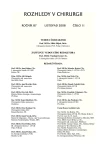Malone Antegrade Continence Enema Stoma in Children with Dysfunctions of Pelvic Organs
Authors:
P. Zerhau; M. Husár; J. Tůma
Authors‘ workplace:
Klinika dětské chirurgie, ortopedie a traumatologie FN, Brno, přednosta: prof. MUDr. P. Gál, Ph. D.
Published in:
Rozhl. Chir., 2008, roč. 87, č. 11, s. 593-595.
Category:
Monothematic special - Original
Overview
Introduction:
Regular large intestine cleansing using rectal enemas in patients with impairment of pelvic organs is technically demanding and, frequently insufficient. Defecation is made easier using Malone antegrade continence enema (MACE), which is based on the same principles as continent vesicostomy.
Aim:
Assessment of up-to-date experience with the MACE in children.
Material and Methodology:
During 2004–2007, the MACE stoma was completed in 7 child patients with spinal dysraphia and severe intestinal dysfunction (meningomyelocele 4x, cerebral palsy 1x, rectal atresia 2x) aged 2–15 y.o.a. In all the subjects, in situ adjusted appendix was used for the construction and, furthermore, continent vesicostomy was performed in two children.
Results:
Seven children were followed up for a period of 10–48 months. The enema volume ranged from 100 to 600 ml and it was administered for 20–30 min. The intestine is cleansed within 20–40 minutes. Frequency of the enemas was once daily in 6 patients and every other day in one girl. Complete continence was achieved and obstipation resolved in 5 children, negligible soiling of a diaper lining persisted in 2 subjects. Stenosis of the appendix stoma in two children was managed by its dilation 3 and 5 months postoperatively.
Conclusion:
MACE stoma facilitates regular cleansing of the large intestine and subsequent establishment of stool continence in patients with spinal dysraphia, as well as in patients with any intestinal dysfunction, requiring regular administration of enemas. It is safe to be used in patients with concomittant continent stoma of the urinary tract.
Key words:
obstipation – stool continence – enema – stoma
Sources
1. Malone, P. S.,Ransley, P. G., Kiely, E. M. Preliminary report: the antegrade continence enema. Lancet, 1990, 336 : 1217.
2. Calado, A. A.,Macedo, A.,Barroso, U., et al. The Macedo-Malone antegrade continence enema procedure : early experience. J. Urol., 2005, 173 : 1340–1344.
3. Liloku, R. B., Mure, P. Y., Braga, L., Basset, T., Mouriquand, P. D. The left Monti-Malone procedure: Preliminary results in seven cases. J. Pediatr. Surg., 2002, 37 : 228–231.
4. Herndon, C. D. A., Cain, M. P., Casale, A. J., Rink, R. C. The colon flap/extension Malone antegrade continence enema: an alternative to the Monti-Malone antegrade continence enema. J. Urol., 2005, 174 : 299–302.
5. Bargawi, A., de Valdenebro, M., Furness, P. D., Koyle, M. A. Lessons learned from stomal complications in children with cutaneous catheterizable continent stomas. BJU Int., 2004, 94 : 1344–1347.
6. Monti, P. R., Lara, R. C., Dutra, M. A., de Carvalho, J. R. New techniques for construction of efferent conduits based on the Mitrofanoff principle. Urology, 1997, 49 : 112.
7. Nanigian, D. K., Kurzrock, E. A. Intermediate-term outcome of the simplified laparoscopic antegrade continence enema procedure: less is better. J. Urol., 2008, 179 : 299–303.
Labels
Surgery Orthopaedics Trauma surgeryArticle was published in
Perspectives in Surgery

2008 Issue 11
- Metamizole at a Glance and in Practice – Effective Non-Opioid Analgesic for All Ages
- Metamizole in perioperative treatment in children under 14 years – results of a questionnaire survey from practice
- Possibilities of Using Metamizole in the Treatment of Acute Primary Headaches
Most read in this issue
- The Use of Biodegradable Materials in the Management of Bone Cysts in Children
- Biliary Ileus – Potential Complication of Cholecystolithiasis
- Operation Treatment of the Humeral Shaft Fractures
- Minimally Invasive Surgery in the Czech Republic
